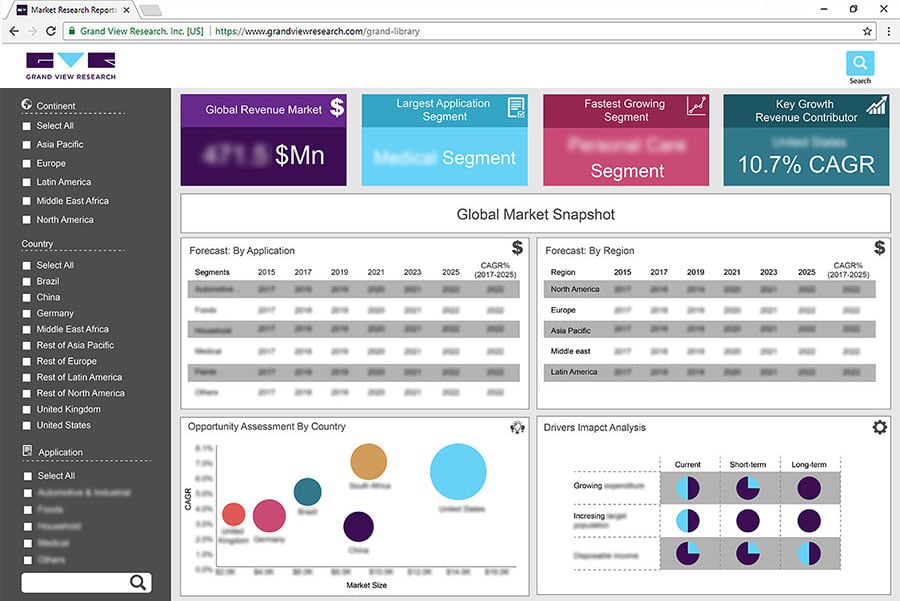
Vacation Rental Market Size, Share & Trends Analysis Report By Booking Mode (Online, Offline), By Accommodation Type (Home, Apartment, Resort/Condominium), By Region, And Segment Forecasts, 2024 - 2030
- Report ID: GVR-4-68038-532-8
- Number of Report Pages: 90
- Format: PDF, Horizon Databook
- Historical Range: 2018 - 2023
- Forecast Period: 2024 - 2030
- Industry: Consumer Goods
Market Segmentation
- Vacation Rental Accommodation Type Outlook (Revenue, USD Million, 2018 - 2030)
- Home
- Apartments
- Resort/Condominium
- Others
- Vacation Rental Booking Mode Outlook (Revenue, USD Million, 2018 - 2030)
- Offline
- Online
- Vacation Rental Regional Outlook (Revenue, USD Million, 2018 - 2030)
- North America
- North America vacation rental market, by accommodation type
- Home
- Apartment
- Resort/condominium
- Others
- North America vacation rental market, by booking mode
- Offline
- Online
- U.S.
- U.S. vacation rental market, by accommodation type
- Home
- Apartment
- Resort/condominium
- Others
- U.S. vacation rental market, by booking mode
- Offline
- Online
- U.S. vacation rental market, by accommodation type
- Canada
- Canada vacation rental market, by accommodation type
- Home
- Apartment
- Resort/condominium
- Others
- Canada vacation rental market, by booking mode
- Offline
- Online
- Canada vacation rental market, by accommodation type
- North America vacation rental market, by accommodation type
- Europe
- Europe vacation rental market, by accommodation type
- Home
- Apartment
- Resort/condominium
- Others
- Europe vacation rental market, by booking mode
- Offline
- Online
- UK
- UK vacation rental market, by accommodation type
- Home
- Apartment
- Resort/condominium
- Others
- UK vacation rental market, by booking mode
- Offline
- Online
- UK vacation rental market, by accommodation type
- Germany
- Germany vacation rental market, by accommodation type
- Home
- Apartment
- Resort/condominium
- Others
- Germany vacation rental accommodation types market, by booking mode
- Offline
- Online
- Germany vacation rental market, by accommodation type
- France
- France vacation rental market, by accommodation type
- Home
- Apartment
- Resort/condominium
- Others
- France vacation rental market, by booking mode
- Offline
- Online
- France vacation rental market, by accommodation type
- Asia Pacific
- Asia Pacific vacation rental market, by accommodation type
- Home
- Apartment
- Resort/condominium
- Others
- Asia Pacific vacation rental market, by booking mode
- Offline
- Online
- China
- China vacation rental market, by accommodation type
- Home
- Apartment
- Resort/condominium
- Others
- China vacation rental market, by booking mode
- Offline
- Online
- China vacation rental market, by accommodation type
- India
- India vacation rental market, by accommodation type
- Home
- Apartment
- Resort/condominium
- Others
- India vacation rental accommodation types market, by booking mode
- Offline
- Online
- India vacation rental market, by accommodation type
- Japan
- Japan vacation rental market, by accommodation type
- Home
- Apartment
- Resort/condominium
- Others
- Japan vacation rental market, by booking mode
- Offline
- Online
- Japan vacation rental market, by accommodation type
- Australia
- Australia vacation rental market, by accommodation type
- Home
- Apartment
- Resort/condominium
- Others
- Australia vacation rental market, by booking mode
- Offline
- Online
- Australia vacation rental market, by accommodation type
- Asia Pacific vacation rental market, by accommodation type
- Central & South America
- Central & South America vacation rental market, by accommodation type
- Home
- Apartment
- Resort/condominium
- Others
- Central & South America vacation rental market, by booking mode
- Offline
- Online
- Brazil
- Brazil vacation rental market, by accommodation type
- Home
- Apartment
- Resort/condominium
- Others
- Brazil vacation rental market, by booking mode
- Offline
- Online
- Brazil vacation rental market, by accommodation type
- Central & South America vacation rental market, by accommodation type
- Middle East & Africa
- Middle East & Africa vacation rental market, by accommodation type
- Home
- Apartment
- Resort/condominium
- Others
- Middle East & Africa vacation rental market, by booking mode
- Offline
- Online
- Saudi Arabia
- Saudi Arabia vacation rental market, by accommodation type
- Home
- Apartment
- Resort/condominium
- Others
- Saudi Arabia vacation rental market, by booking mode
- Offline
- Online
- Saudi Arabia vacation rental market, by accommodation type
- Middle East & Africa vacation rental market, by accommodation type
- North America
Vacation Rental Market Dynamics
Driver: Growing Consumer Preference For Vacation Rental Properties Over Hotels
Vacation rentals offer a variety of high-quality, affordable accommodation options at several destinations. As per the Turnkey blog in 2019, the industry is at roughly a 10% growth rate this decade, largely affected by travelers’ desires to stay in a home instead of a hotel. According to the TurnKey Vacation Rentals’ 2019 Consumer Travel Survey, 64% travelers preferred staying in vacation rentals as opposed to hotels, which is up by 10% from the 2018 Consumer Travel Survey. The industry has skyrocketed over the last few years and only declined after the COVID-19 outbreak, owing to lockdowns and restrictions on travel. Before the pandemic, travel was on the rise, and a growing consumer interest was observed in experiencing higher-quality and home-like vacations, which supported the growth of the vacation rental industry. People were booking longer trips, spending more money, and traveling further to find the ideal destination based on their preferences.
Driver: High Prominence Of Transformational And Wellness Trips Post Lockdown
The evolving trend of transformational travel surrounding wellness trips in order to restore balance and transform the mind, sprit, and body is expected to drive the vacation rental market over the forecast period. According to a blog by Hospitality Net, typical holidays such as sun, sand, and sea; skiing; sightseeing; and shopping are expected to be high in demand. Furthermore, higher preference for domestic travel compared to international travel is likely to boost the domestic vacation rental business across the globe as soon as borders are re-opened. The increasing resurgence of international trips post vaccine and virus control would also drive the growth of the vacation rental market.
Restraint: Declining Disposable Income Among Consumers
Income reduction of consumers is attributed to business loss, job loss, or lower income by enterprises, which has led to cutting down of their spending capacity or savings. According to The World Financial Review, the income of self-employed gig workers declined by 30% in the first two weeks of April 2020, compared to the pre-crisis average. Income from loans declined by 44% for regular salaried workers and 56% for gig workers owing to the tightening of lending standards. According to the group, disposable income spending declined by 60% across all worker groups across the globe. This scenario is expected to endure and have long-lasting impacts on the vacation rental market.
What Does This Report Include?
This section will provide insights into the contents included in this vacation rental market report and help gain clarity on the structure of the report to assist readers in navigating smoothly.
Vacation rental market qualitative analysis
-
Industry overview
-
Industry trends
-
Market drivers and restraints
-
Market size
-
Growth prospects
-
Porter’s analysis
-
PESTEL analysis
-
Key market opportunities prioritized
-
Competitive landscape
-
Company overview
-
Financial performance
-
Product benchmarking
-
Latest strategic developments
-
Vacation rental market quantitative analysis
-
Market size, estimates, and forecast from 2017 to 2030
-
Market estimates and forecast for product segments up to 2030
-
Regional market size and forecast for product segments up to 2030
-
Market estimates and forecast for application segments up to 2030
-
Regional market size and forecast for application segments up to 2030
-
Company financial performance



